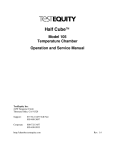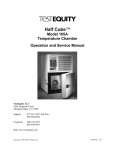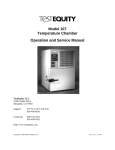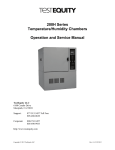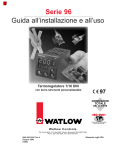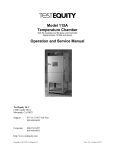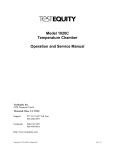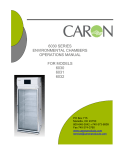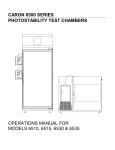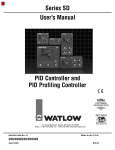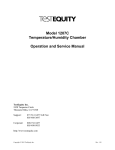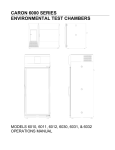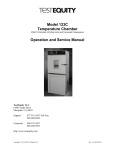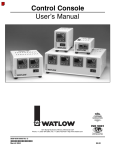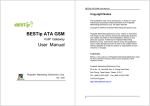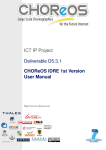Download With Watlow 96 Controller and SD Limit
Transcript
Half Cube™ Model 105 Temperature Chamber Operation and Service Manual TestEquity Inc. 2450 Turquoise Circle Thousand Oaks, CA 91320 Support: 877-512-3457 Toll Free 805-480-3697 Corporate: 800-732-3457 805-498-9933 http://chamber.testequity.com Rev. 2.2 Table of Contents Chapter 1 – Safety Instructions ________________________________________________ 1-1 Introduction ____________________________________________________________________1-1 Installation Safety Notices _________________________________________________________1-1 Operation Safety Notices __________________________________________________________1-1 Chapter 2 – Installation ______________________________________________________ 2-1 Unpacking ______________________________________________________________________2-1 Preparation For Use ______________________________________________________________2-1 Installation Location______________________________________________________________2-1 Reversible Chamber Door _________________________________________________________2-1 Chapter 3 – Operation _______________________________________________________ 3-1 Introduction ____________________________________________________________________3-1 Front Panel Switches _____________________________________________________________3-1 POWER Switch________________________________________________________________________ 3-1 TEMP Switch _________________________________________________________________________ 3-1 Summary of Chamber Operation ___________________________________________________3-1 Loading the Chamber ____________________________________________________________3-2 Port Plugs ____________________________________________________________________________ 3-2 Avoiding Moisture _____________________________________________________________________ 3-3 Internal Test Fixtures ___________________________________________________________________ 3-3 Chapter 4 – Temperature Controller ___________________________________________ 4-1 Introduction ____________________________________________________________________4-1 Security Features_______________________________________________________________________ 4-1 Temperature Controller Keys and Displays __________________________________________4-2 Static Set Point Control ___________________________________________________________4-2 Profile Control __________________________________________________________________4-3 Entering A Profile ______________________________________________________________________ 4-3 Running A Profile ______________________________________________________________________ 4-3 Profile Example 1 ______________________________________________________________________ 4-4 Profile Example 2 ______________________________________________________________________ 4-5 RS-232 Interface _________________________________________________________________4-6 GPIB Interface (Optional) _________________________________________________________4-6 Chapter 5 – Limit Controller__________________________________________________ 5-1 Introduction ____________________________________________________________________5-1 Limit Controller Keys and Displays ________________________________________________________ 5-2 How to Set the High and Low Temperature Safety Limits _______________________________________ 5-2 Resetting a Limit Condition ______________________________________________________________ 5-2 Chapter 6 – Frequently Asked Questions________________________________________ 6-1 Chapter 7 – Specifications ____________________________________________________ 7-1 Model 105 Chamber Specifications__________________________________________________7-1 Series 96 Temperature Controller Specifications ______________________________________7-2 Table of Contents Chapter 8 – Maintenance _____________________________________________________ 8-1 Preventive Maintenance Schedule___________________________________________________8-1 Daily or As Needed_____________________________________________________________________ 8-1 Every 6 Months________________________________________________________________________ 8-1 Every 12 Months_______________________________________________________________________ 8-1 How to clean the chamber interior and exterior _______________________________________________ 8-2 How to listen for abnormal noise or vibration ________________________________________________ 8-2 How to inspect the door seal ______________________________________________________________ 8-2 How to clean the condenser ______________________________________________________________ 8-2 How to inspect the electrical/refrigeration compartment ________________________________________ 8-3 How to verify the chamber performance_____________________________________________________ 8-4 How to verify the calibration _____________________________________________________________ 8-5 Temperature Controller Calibration ________________________________________________________ 8-6 Temperature Controller Calibration Procedure________________________________________________ 8-6 Theory of Operation______________________________________________________________8-7 Overview_____________________________________________________________________________ 8-7 Heating System ________________________________________________________________________ 8-7 Refrigeration System____________________________________________________________________ 8-7 Troubleshooting _________________________________________________________________8-8 Refrigeration System Charging Instructions __________________________________________8-9 R-410A Charge ________________________________________________________________________ 8-9 Recommended Spare Parts _______________________________________________________8-10 Major Replacement Parts ________________________________________________________8-10 Series 96 Temperature Controller Setup Parameters __________________________________8-11 SD Limit Controller Setup Parameters _____________________________________________8-12 Chapter 9 – Warranty _______________________________________________________ 9-1 Chapter 10 – Drawings______________________________________________________ 10-1 Chapter 1 – Safety Chapter 1 – Safety Instructions Introduction Follow all CAUTION notices to prevent damage to the chamber or your test sample. Failure to follow all CAUTION notices may void your warranty. CAUTION may also indicate a potentially hazardous situation which, if not avoided, may result in minor or moderate personal injury. WARNING indicates a potentially hazardous situation which, if not avoided, could result in death or serious injury. The safety alert symbol ! precedes a general CAUTION or WARNING statement. The electrical hazard symbol 2 precedes an electric shock hazard CAUTION or WARNING statement. Installation Safety Notices 2 WARNING: The power cord is equipped with a NEMA 5-15P grounded/polarized plug. To prevent a shock hazard, DO NOT defeat the ground or polarization feature. This device MUST be plugged into a properly grounded and polarized outlet. ! CAUTION: The minimum clearance you should allow for proper ventilation must be at least 12" from the rear of the chamber. ! CAUTION: This chamber is designed for operation in a conditioned laboratory environment. Operation above 30°C (85°F) or below 16°C (60°F) ambient room temperature is NOT recommended. Operation Safety Notices ! CAUTION: The “Series 96 User’s Manual” is a general manual and is written by the manufacturer, Watlow, for a wide variety of applications and configurations. Not all features or functions are applicable. Only the capabilities of a model 96A0-CKDR-AABB, as described on page A.7 of the “Series 96 User’s Manual” are applicable. ! CAUTION: The Series 96 Temperature Controller has been properly configured by TestEquity to match the chamber’s system requirements and to perform optimally over a wide range of operating conditions. Improper modifications to these setup values can result in erratic performance and unreliable operation. Do not attempt to modify the setup values, unless you thoroughly understand what you are doing. If there is any doubt, please call TestEquity before proceeding. TestEquity 105 Temperature Chamber Page 1-1 Chapter 1 – Safety ! CAUTION: Always verify that the Limit Controller settings for high and low limits are set to temperatures that are appropriate for your test sample. ! WARNING: Do NOT put items in the chamber that could burn or explode at high temperatures. This chamber uses open wire heating elements which generate surface temperatures over 1000ºF. This is NOT an explosion-proof chamber. ! WARNING: Do NOT put items in the chamber that can emit corrosive vapors or substances. ! WARNING: This chamber is NOT a curing oven. There are NO provisions for venting fumes. ! WARNING: The chamber door must remain closed while the chamber is operating. If you need to open the door while the chamber is operating, wear safety goggles to prevent the high velocity airflow from blowing particles or objects into your eyes. ! WARNING: This chamber operates at extreme temperatures. Avoid contact with air, objects, and surfaces that are hot or cold to prevent severe burns or frostbite. Protective gloves are recommended. ! CAUTION: If your test sample is energized, it may be capable of raising the workspace temperature beyond safe limits. This could occur if your test sample exceeds the live load rating of the chamber or if the chamber’s refrigeration system fails. You are responsible for providing thermal protection devices to your test sample. ! CAUTION: To prevent damage to your test sample and the chamber’s compressor, do not exceed the live load rating of the chamber. Page 1-2 TestEquity 105 Temperature Chamber Chapter 2 – Installation Chapter 2 – Installation Unpacking Inspect the shipping container for any signs of visible damage. Notify the carrier and TestEquity immediately if there are signs of shipping damage. 1. 2. 3. 4. Cut the bands that hold the packaging together. Remove the top cover and top foam inserts. Remove the outer box. Carefully lift the chamber off the pallet. This should be done with at least two people. Preparation For Use 1. 2. 3. 4. 5. Inspect the chamber for signs of shipping damage. Read this entire manual. Select a suitable location to install the chamber. Connect to a 120 VAC, 60 Hz power source with a minimum 15 Amp breaker. Perform following the procedure “How to verify the chamber performance” in the Maintenance chapter of this manual to make sure that no damage has occurred in shipment. Installation Location The chamber will produce a moderate amount of heat during normal operation. Locate the chamber in an area with adequate ventilation to prevent excessive heat build-up. The chamber must be on a solid and level surface that is rated to hold at least 100 pounds. 2 WARNING: The power cord is equipped with a NEMA 5-15P grounded/polarized plug. To prevent a shock hazard, DO NOT defeat the ground or polarization feature. This device MUST be plugged into a properly grounded and polarized outlet. ! CAUTION: The minimum clearance you should allow for proper ventilation must be at least 12" from the rear of the chamber. ! CAUTION: This chamber is designed for operation in a conditioned laboratory environment. Operation above 30°C (85°F) or below 16°C (60°F) ambient room temperature is NOT recommended. Reversible Chamber Door The chamber door can be mounted to open from the left or right side. The chamber cabinet has mounting holes on both sides for the hinges and door latch. If you reverse the door, see “How to inspect the door seal” in the Maintenance chapter of this manual to make sure the hinges and door latch are adjusted correctly. TestEquity 105 Temperature Chamber Page 2-1 Chapter 3 – Operation Chapter 3 – Operation Introduction The Front Panel Switches control power to the temperature controller and all chamber functions. The Temperature Controller controls the temperature of the chamber. The Temperature Controller automatically turns the refrigeration system on or off as required based on the deviation from temperature set point. Front Panel Switches POWER Switch The POWER Switch controls power to the entire chamber. The POWER Switch illuminates when it is ON. TEMP Switch The TEMP Switch enables all chamber functions. When the TEMP Switch is OFF and the Power Switch is ON, only the Temperature Controller is operational. When both the TEMP and POWER Switches are ON, the chamber’s temperature conditioning system will function to maintain the temperature set point. The TEMP Switch illuminates when it is ON. Summary of Chamber Operation 1. 2. 3. 4. 5. Turn the POWER Switch ON. Enter the desired temperature safety limits on the Limit Controller. Enter the desired temperature set point on the Temperature Controller. Load your test sample in the chamber. Turn the TEMP Switch ON. TestEquity 105 Temperature Chamber Page 3-1 Chapter 3 – Operation Loading the Chamber ! WARNING: Do NOT put items in the chamber that could burn or explode at high temperatures. This chamber uses open wire heating elements that generate surface temperatures over 1000ºF. This is NOT an explosion-proof chamber. ! WARNING: Do NOT put items in the chamber that can emit corrosive vapors or substances. ! WARNING: This chamber is NOT a curing oven. There are NO provisions for venting fumes. ! WARNING: The chamber door must remain closed while the chamber is operating. If you need to open the door while the chamber is operating, wear safety goggles to prevent the high velocity airflow from blowing particles or objects into your eyes. ! WARNING: This chamber operates at extreme temperatures. Avoid contact with air, objects, and surfaces that are hot or cold to prevent severe burns or frostbite. Protective gloves are recommended. ! CAUTION: If your test sample is energized, it may be capable of raising the workspace temperature beyond safe limits. This could occur if your test sample exceeds the live load rating of the chamber or if the chamber’s refrigeration system fails. ! CAUTION: To prevent damage to your test sample and the chamber’s compressor, do not exceed the live load rating of the chamber. Live Load Capacity for Model 105 Temp +23°C 0°C 200 W 175 W Watts –10°C 165 W –20°C 145 W –30°C 90 W –40°C 10 W Port Plugs Foam port plugs are provided with a gray silicone surface on one side. The port plug should be inserted with the gray silicone surface facing the inside of the chamber. Port plugs should be considered expendable and be replaced when they no longer provide a good seal. Page 3-2 TestEquity 105 Temperature Chamber Chapter 3 – Operation Perfrmance of all chambers are significantly effected by the characteristics of your test sample. Factors include size, weight, material, shape, and power dissipation if energized. The test sample should be placed in the chamber in a manner that allows for air circulation. The air plenum is located on the back wall of the chamber, where air is sucked in from the bottom and exits from the top. You should not place the test sample directly on the chamber floor. It should be placed on the shelf. Multiple test samples should be distributed throughout the chamber to ensure even airflow and minimize temperature gradients. If necessary, an additional shelf should be used to evenly distribute the load. Verify that the temperature gradients are within acceptable limits, by measuring the chamber temperature at strategic points using a multipoint thermocouple meter or datalogger. You may find that the temperature throughout the chamber is even, but always different from what the temperature controller indicates. The correct way to adjust what the temperature controller “displays” compared to what is measured at some point other than the controller’s sensor is with the “Calibration Offset” parameter. See page 5.2 of the “Series 96 User’s Manual” for details. Avoiding Moisture Any time the ambient air is subjected to temperatures below the dewpoint, moisture will condense out of the air. The effect is ice or frost during low temperature operation. When the chamber is heated above 0°C, the ice or frost will turn into water. To avoid moisture condensation, make sure the port plugs are inserted at all times. Also, avoid opening the chamber door while the chamber is operating at temperatures below room ambient. When a low temperature test is completed, warm the chamber to at least room ambient before opening the chamber door and before removing your test sample. Internal Test Fixtures Some applications require internal fixtures to support test samples and provide a convenient method of connecting wires and sensors. Fixtures must be designed to minimize their impact on chamber functionality and performance. Fixtures should be designed for easy removal to permit maintenance and cleaning of the chamber. The chamber liner should never be drilled or screwed into. This will compromise the integrity of the liner and permit moisture migration due to condensation into the insulation, which will eventually impact performance and lead to premature rusting of the outer cabinet. Fixtures should be constructed of stainless steel. This also applies to all screws and fasteners. All welds should be passivated. To prevent rust and corrosion, never use iron or mild steel even if it is painted or plated. Aluminum may be used. However, since the specific heat of aluminum is double that of steel, it represents a greater load and will have more impact on the chamber performance. Make sure that all connectors, wiring, pc boards, and auxiliary components can withstand the temperature extremes that they will be subjected to. In some cases, these components may not be able to last after repeated tests and should be considered expendable. TestEquity 105 Temperature Chamber Page 3-3 Chapter 4 – Temperature Controller Chapter 4 – Temperature Controller Introduction This chapter provides an overview on how to operate the Series 96 Temperature Controller. The Series 96 Controller provides easy single set point operation and profile programming. A large LED readout indicates the actual chamber temperature with 0.1°C or °F display resolution. The Series 96 Controller can store two profiles with up to 8-steps in each file. The user-interface is organized in menus. ! CAUTION: The “Series 96 User’s Manual” is a general manual and is written by the manufacturer, Watlow, for a wide variety of applications and configurations. Not all features or functions are applicable. Only the capabilities of a model 96A0-CKDR-AABB, as described on page A.7 of the “Series 96 User’s Manual” are applicable. ! CAUTION: The Series 96 Temperature Controller has been properly configured by TestEquity to match the chamber’s system requirements and to perform optimally over a wide range of operating conditions. Improper modifications to these setup values can result in erratic performance and unreliable operation. Do not attempt to modify the setup values, unless you thoroughly understand what you are doing. If there is any doubt, please call TestEquity before proceeding. Security Features The Series 96 Temperature Controller has several levels of security to prevent unauthorized users from changing critical configuration parameters. Only the Set Point, Program, and Operations menus are configured to “Change”, meaning full user access is possible. All other menus are configured to “Read Only”. TestEquity does not recommend that these security levels be changed for most applications. However, there will be times when “Change” is necessary. For example, you may need to access to Setup Page in order to change from °C to °F display. To change these levels of security, see the “Lockout Menu” page 6.19 of the “Series 96 User’s Manual”. TestEquity 105 Temperature Chamber Page 4-1 Chapter 4 – Temperature Controller Temperature Controller Keys and Displays Output Indicator Lights Indicates controller output activity. 1 - Heat 3 - Low Temp Mode 2 - Cool 4 - Computer Interface Activity Profile Mode Indicator Light On if in Profile Mode. Upper Display Indicates actual chamber temperature during operation, or the value of the parameter in the lower display. Up Key • Changes the upper display to a higher value, or moves up through a list of values. • Moves from menu to menu in a page. • Increases the set point value in lower display. Lower Display Indicates temperature set point during operation, or the parameter whose value appears in the upper display. Advance Key Advances the lower display through the configuration parameters. To reverse direction, press and hold this key while repeatedly pressing the Up key. Infinity/Home Key • Returns to the Home Page (process/actual display and custom toolbar). • Resets a latching alarm. • Resets a latching input sensor error. Down Key • Changes the upper display to a lower value, or moves up through a list of values. • Moves from menu to menu in a page. • Decreases the set point value in lower display. Figure 4.1 – Temperature Controller Keys and Displays Static Set Point Control The Temperature Controller is in Static Set Point mode when it is not running a profile. The Upper Display shows the actual chamber workspace temperature. The Lower Display shows the desired Set Point. To enter a temperature Set Point, simply press the ¿ or ¯ key to enter the desired temperature. Page 4-2 TestEquity 105 Temperature Chamber Chapter 4 – Temperature Controller Profile Control A profile consists of temperature set points that vary over time. Profiles are entered in the Program Menu. The Series 96 Controller can store two profiles with up to 8-steps in each file. The files may be linked to create a single 16-step profile. Profile programming details can be found in Chapter 7 of the “Series 96 User’s Manual”. References to “Event Outputs”, “Rate”, and “Wait-for Event Input” are not applicable. Entering A Profile To enter the Program Menu, press the ‰ (Advance) key. Each press of the ‰ key will scroll you through the Program Menu. Use the ¿ or ¯ key to enter the desired value at each prompt. Programming Hints: • The first step in a program should be an initialization step of 1-second. • The next to last step establishes a condition to end on. For example, you may want to end the program by holding at +23°C, so this step would be to go to +23°C. • TestEquity recommends having the end step type to be Hold. TestEquity does NOT recommend using an end step type of Off. This does not turn off the chamber fan. The chamber temperature can reach +50°C just from heat generated by the fan, and even higher if your test sample is energized. Running A Profile To select a profile, press the ˆ (Infinity) key once. The will put you in the Pre-run mode, and the profile mode indicator will flash. Each press of the ‰ key will scroll you through the Pre-run Menu. Here, you can select a profile and step number to start or to resume a running profile. Use the ¿ or ¯ key to enter the desired File, Step, or Resume condition that you want to start running. To run the profile, press the ˆ key. The profile mode indicator will remain ON, indicating that the profile is running. Hint: If you only have one profile and want to start at step number one, simply press the ˆ key twice. You may monitor the current step condition of a running profile by pressing the ‰ key. Each press of this key will scroll you through the current step parameters. To end a running profile, press the ˆ key once. TestEquity 105 Temperature Chamber Page 4-3 Chapter 4 – Temperature Controller Profile Example 1 This profile will be stored in File 1. Cycle between +85°C and 0°C. Go to each temperature as fast as possible. Soak at each temperature for 30 minutes. Temperature must be within 3°C before the soak time will start. Total number of cycles is 4. End by holding at +23°C. Step 1. 2. 3. 4. 5. 6. 7. 8. Description Start at +23°C. Go to +85°C as fast as possible. Soak at +85°C for 30 minutes. Time will not start until temperature is within 3°C (+82°C) Go to 0°C as fast as possible. Soak at 0°C for 30 minutes. Time will not start until temperature is within 3°C (+3°C) Jump back to Step 2 of this profile (#1). Repeat 3 times, for a total of 4 cycles. Go to +23°C as fast as possible. End with a hold at +23°C. Lower Upper Lower Upper [FiLE] [StEP] [StyP] [~~SP] [Hour] [Min] [~SEC] [FiLE] [StEP] [StyP] [~~SP] [Hour] [Min] [~SEC] [FiLE] [StEP] [StyP] [Hour] [Min] [~SEC] [Wde] [FiLE] [StEP] [StyP] [~~SP] [Hour] [Min] [~SEC] [~~~1] (Step 1) [~~~1] [StPt] [~2#0] [~~~0] [~~~0] [~~~1] [~~~1] (Step 2) [~~~2] [StPt] [~8%0] [~~~0] [~~~0] [~~~1] [~~~1] (Step 3) [~~~3] [SoAH] [~~~0] [~~30] [~~~0] [~~~3] [~~~1] (Step 4) [~~~4] [StPt] [~~)0] [~~~0] [~~~0] [~~~1] [FiLE] [StEP] [StyP] [Hour] [Min] [~SEC] [Wde] [FiLE] [StEP] [StyP] [~~JF] [~~JS] [~~JC] [StEP] [StyP] [~~SP] [Hour] [Min] [~SEC] [FiLE] [StEP] [StyP] [~End] [~~~1] (Step 5) [~~~5] [SoAH] [~~~0] [~~10] [~~~0] [~~~3] [~~~1] (Step 6) [~~~6] [~~JL] [~~~1] [~~~2] [~~~3] [~~~7] (Step 7) [StPt] [~2#0] [~~~0] [~~~0] [~~~1] [~~~1] (Step 8) [~~~8] [~End] [HOLd] Page 4-4 TestEquity 105 Temperature Chamber Chapter 4 – Temperature Controller Profile Example 2 This profile will be stored in File 2. Cycle between +50°C and -10°C. Go to each temperature in 20 minutes (+50°C and -10°C = 60°C/20 Minutes = 3°C/minute). Soak at each temperature for 1 hour. Total number of cycles is 10. End by holding at +23°C. Step 1. 2. 3. 4. 5. 6. 7. 8. Description Start at +23°C. Go to +50°C in 20 minutes. Soak at +20°C for 1 hour. Go to -10°C in 20 minutes. Soak at -10°C for 1 hour. Jump back to Step 2 of this profile (#2). Repeat 9 times, for a total of 10 cycles. Go to +23°C in 20 minutes. End with a hold at +23°C. Lower Upper Lower Upper [FiLE] [StEP] [StyP] [~~SP] [Hour] [Min] [~SEC] [FiLE] [StEP] [StyP] [~~SP] [Hour] [Min] [~SEC] [FiLE] [StEP] [StyP] [Hour] [Min] [~SEC] [Wde] [FiLE] [StEP] [StyP] [~~SP] [Hour] [Min] [~SEC] [~~~2] (Step 1) [~~~1] [StPt] [~2#0] [~~~0] [~~~0] [~~~1] [~~~2] (Step 2) [~~~2] [StPt] [~5)0] [~~~0] [~~20] [~~~0] [~~~2] (Step 3) [~~~3] [SoAH] [~~~1] [~~~0] [~~~0] [~OFF] [~~~2] (Step 4) [~~~4] [StPt] [-1)0] [~~~0] [~~20] [~~~0] [FiLE] [StEP] [StyP] [Hour] [Min] [~SEC] [Wde] [FiLE] [StEP] [StyP] [~~JF] [~~JS] [~~JC] [StEP] [StyP] [~~SP] [Hour] [Min] [~SEC] [FiLE] [StEP] [StyP] [~End] [~~~2] (Step 5) [~~~5] [SoAH] [~~~1] [~~~0] [~~~0] [~OFF] [~~~2] (Step 6) [~~~6] [~~JL] [~~~2] [~~~2] [~~~9] [~~~7] (Step 7) [StPt] [~2#0] [~~~0] [~~20] [~~~0] [~~~2] [~~~8] (Step 8) [~End] [HOLd] TestEquity 105 Temperature Chamber Page 4-5 Chapter 4 – Temperature Controller RS-232 Interface The Temperature Controller has an RS-232C interface. A DB-9 connector is located on the rear panel. It is wired to accommodate a null-modem cable. To communicate with the controller from a PC, you need to run software that uses the Modbus RTU protocol. Modbus programming register numbers are on page A.3 of the “Series 96 User’s Manual”. RS-232C programming resources can be downloaded from: http://chamber.testequity.com/rs232.html GPIB Interface (Optional) The optional GPIB interface consists of an external converter box that connects to the chamber’s RS-232C interface. GPIB programming resources can be downloaded from: http://chamber.testequity.com/gpib.html Page 4-6 TestEquity 105 Temperature Chamber Chapter 5 – Limit Controller Chapter 5 – Limit Controller Introduction The SD Limit Controller is a protection device. It turns the chamber OFF if the workspace temperature exceeds either a high temperature or low temperature limit. You can set these limits to correspond to the maximum and minimum temperature that your test sample can safely withstand. This provides protection against someone setting the Temperature Controller to a temperature that is unsafe for the test sample. It also provides protection in the unlikely event of a chamber system component failure. The Limit Controller has its own temperature sensor (thermocouple) and functions completely independent of the Temperature Controller. ! CAUTION: The “Series SD User’s Manual” is a general manual and is written by the manufacturer, Watlow, for a wide variety of applications and configurations. It is provided for a reference only. Not all features or functions are applicable. Only the capabilities of a model SD3L-HJAA-AARG, as described on page 49 of the “Series SD User’s Manual” are applicable. ! CAUTION: The Series SD Limit Controller has been properly configured by TestEquity to match the chamber’s system requirements. Improper modifications to these setup values can result in unreliable and unsafe operation. Do not attempt to modify the setup values, unless you thoroughly understand what you are doing. Setup examples in the “Series SD User’s Manual” are NOT applicable to this chamber. If there is any doubt, please call TestEquity before proceeding. The correct values are documented in the “Series SD Limit Controller Setup Parameters” section of this manual. ! CAUTION: NEVER select “Default Parameters” in the Factory Page. This will erase all the correct values which are documented in the “Series SD Limit Controller Setup Parameters” section of this manual. ! CAUTION: Always verify that the Limit Controller settings for high and low limits are set to temperatures that are appropriate for your test sample. TestEquity 105 Temperature Chamber Page 5-1 Chapter 5 – Limit Controller Limit Controller Keys and Displays Active Output Indicator Lights Lit when the limit setting is exceeded. Only light 1 is applicable for this configuration. Right Display Indicates the Low Limit Set Point during normal operation, or the parameter whose value appears in the right display. Left Display Indicates the High Limit Set Point during normal operation, or the value of the parameter in the right display in other pages. Advance Key Advances the right display through parameter prompts Reset Key Returns to the Home Page. or Resets the limit. Up/Down Keys In the Home Page, adjusts the limit set point. In other pages, changes the left display to a higher or lower value. Figure 4.1 – Limit Controller Keys and Displays How to Set the High and Low Temperature Safety Limits 1. Press the Advance key once to get the [L1Lo] prompt in the right display. This is the Low Limit Set Point prompt. 2. Press the ▲or ▼ key to enter the desired Low Limit Set Point in the left display. Make sure it is lower than your actual chamber temperature set point, and at least below room temperature to prevent nuisance tripping. 3. Press the Advance key once to get the [L1HI] prompt in the left display. This is the High Limit Set Point prompt. 4. Press the ▲or ▼ key to enter the desired High Limit Set Point in the left display. Make sure it is higher than your actual chamber temperature set point to prevent nuisance tripping. 5. Press the Reset Key to return to the Home Page. 6. The left display will show the High Limit Set Point while the right display will show the Low Limit Set Point. Resetting a Limit Condition If either the High or Low Limit is exceeded, the Limit Controller will flash either [LIHi] or [L1Lo] respectively in the right display. It will also shut down all chamber functions. The Limit Controller cannot be reset until the temperature returns to within the limit set points. Then, you must press the Reset Key to resume normal operation. Page 5-2 TestEquity 105 Temperature Chamber Chapter 6 – Frequently Asked Questions Chapter 6 – Frequently Asked Questions Why does my chamber heat or cool slower than the published specifications? You can determine if the chamber is operating properly by following the procedure in “How to verify the chamber performance”. Performance is significantly effected by the characteristics of your test sample. Factors include size, weight, material, shape, and power dissipation if energized. The test sample should be placed in the chamber in a manner that allows for air circulation. You should not place the test sample directly on the chamber floor. It should be placed on the shelf. Multiple test samples should be distributed throughout the chamber to ensure even airflow and minimize temperature gradients. If necessary, an additional shelf should be used to evenly distribute the load. How can I modify the chamber to cool faster or colder? Unfortunately, there is nothing you can do to improve upon the designed-in performance. TestEquity does NOT recommend using CO2 or LN2 in this chamber to achieve colder or faster cooling due to reliability and safety considerations, so it is NOT an available option. Modifying the chamber to add CO2 or LN2 will permanently damage the chamber and void the warranty. Why is there water/ice/snow in the chamber? Any time the ambient air is subjected to temperatures below the dewpoint, moisture will condense out of the air. The effect is ice or frost during low temperature operation. When the chamber is heated above 0°C, the ice or frost will turn into water. To avoid moisture condensation, make sure the port plugs are inserted at all times. Also, avoid opening the chamber door while the chamber is operating at temperatures below room ambient. When a low temperature test is completed, warm the chamber to at least room ambient before opening the chamber door and before removing your test sample. My test specification requires convection heat only. Can I turn the circulator motor off? NO! This will damage the heating and refrigeration systems and void the warranty. You need a “gravity convection oven” for that kind of test. How accurate is the chamber? That’s a loaded question! There is no “chamber accuracy” specification as such. The answer requires an understanding of several performance parameters. Control Tolerance – The Temperature Controller uses a thermocouple control sensor, which is located in the intake airflow within the air plenum. Control tolerance is a measure of how much the temperature varies after stabilization at the control sensor. It is a measure of the relative variations, NOT the absolute accuracy of the readout. The control tolerance specification for this chamber is ±0.5°C, or a total of 1°C. For example, the temperature set point may be –10.0°C. The actual temperature varies between –9.9°C and –10.6°C. This corresponds to –0.6°C and +0.1°C or a total of 0.7°C of RELATIVE variations. These specifications are for an empty chamber. The addition of a test sample may effect the control variations. In some instances, the test sample will reduce these variations. TestEquity 105 Temperature Chamber Page 6-1 Chapter 6 – Frequently Asked Questions Uniformity – Also known as Gradients. This is a measure of variations in temperature at different locations throughout the chamber interior, at the same time, after stabilization. The uniformity specification for this chamber is ±1.0°C or a total of 2°C, when measured at least 2" away from the chamber interior walls. These specifications are for an empty chamber. The addition of a test sample may effect the temperature uniformity. For example, an energized test sample will produce a higher temperature near the sample. Controller Accuracy – This is the ability of the temperature controller to accurately display a temperature measurement when compared to a standard. The controller display accuracy is ±0.55°C, ±1 LSD. However, the total measurement accuracy in the chamber includes the thermocouple sensor wire accuracy. Thermocouple wire accuracy is ±1°C or 0.75% of reading, whichever is greater. Therefore, total system accuracy over the chamber’s typical operating range is typically ±1.55°C, ±1 LSD. This is not a measurement of chamber performance. Can I operate the chamber on its side? No, the chamber can only be operated in the upright position. Operating the chamber on its side will cause permanent damage to the refrigeration system and void the warranty. I’m not going to use the chamber for a while. Is there anything I should do to prepare it for storage? Perform ALL the steps in the Preventive Maintenance Schedule before placing the chamber into storage. This will ensure that the chamber will be ready to operate when it is taken out of storage. If the chamber has a problem and is still under warranty, these problems should be resolved before being placed into storage, since the warranty period starts from the date of shipment. The chamber should be stored in a conditioned environment. Do not store it outside or where it will be subjected to dirt or excessive moisture. I haven’t used the chamber for a while. Is there anything I should do to prepare it for operation? Perform ALL the steps in the Preventive Maintenance Schedule before placing the chamber back into service. This will ensure that nothing has been damaged and that a leak has not developed. Can/Should I put a filter in front of the condenser air inlet? No, TestEquity does not recommend this. Just follow the maintenance procedures and clean the condenser fins periodically. How often should I charge the refrigeration system? This chamber uses a closed-loop refrigeration system. Just like your refrigerator at home, it does not need periodic charging. If the charge is low, this means that there is a leak. Leaks should be repaired before recharging. What kind of Freon does the chamber use? The word Freon® is a DuPont registered trade name for their CFC-based refrigerants and is incorrectly used as a generic term for refrigerants. TestEquity chambers do not use CFC-based refrigerants. The system uses R-410A, which is also known as DuPont Suva® 410A. Page 6-2 TestEquity 105 Temperature Chamber Chapter 7 – Specifications Chapter 7 – Specifications Model 105 Chamber Specifications Temperature Range Control Tolerance Uniformity –40°C to +130°C ±0.5°C, ±0.2°C Typical (Measured at the control sensor after stabilization) ±1.0°C, ±0.5°C Typical (Variations throughout the chamber after stabilization) Live Load Capacity @ (Watts) +23°C 200 W 0°C 175 W –10°C 165 W –20°C 145 W –30°C 90 W –40°C 10 W End Temp –10°C –20°C 5 min 7 min 15 min 17 min –30°C 10 min 20 min –35°C 13 min 23 min Cool Down Transition Time (empty chamber) Start Temp to Æ +23°C +85°C +23°C ----8 min 0°C 3 min 13 min –40°C 22 min 31 min Heat Up Transition Time (empty chamber) End Temp Start Temp to Æ +23°C +50°C +85°C +23°C ----- 1.5 min 6 min 0°C 2 min 4 min 7.5 min –20°C 3 min 5 min 8 min –40°C 4.5 min 7.5 min 11 min *Note: Transition times are measured after a 30 minute soak at the start temperature. To calculate rate of change for a particular condition, take the difference between the Start Temp and End Temp and divide by the Transition Time. Cool Down Example (empty): From +85°C to –20°C = 105°C / 17 min = 6.18°C/min. Heat Up Example (empty: From -40°C to +85°C = 125°C / 11 min = 11.36°C/min. Power Requirements Input Voltage Current Draw Workspace Dimensions Outside Dimensions Min. Installed Clearance Access Ports Weight 120 VAC nominal (110 to 126 VAC), Single Phase, 60 Hz 10 A maximum; Recommended Service 15 A 12" W x 9" H x 8" D (0.5 cubic feet) 16.5" W x 25" H x 20" D (nominal) Door latch adds 2" to width. Circulator motor housing adds 2" to depth in rear. 12" from the rear 2" Port on left and right side (two total), Supplied with foam plugs 114 pounds NOTE: Performance is typical and based on operation at 23°C (73°F) ambient and nominal input voltage. Designed for use in a normal conditioned laboratory. Operation at higher ambient temperatures will result in decreased cooling performance. Low end limit derates to -38°C when operating above 27°C (80°F) ambient. Operation above 30°C (85°F) or below 16°C (60°F) ambient is not recommended. TestEquity 105 Temperature Chamber Page 7-1 Chapter 7 – Specifications Series 96 Temperature Controller Specifications Specifications as configured for the TestEquity Model 105 Chamber. Accuracy & Sensor Conformity* ±0.55°C, ±1 LSD with type-T thermocouple input Stability ±0.1°C/°C rise in ambient Communications RS-232C serial communications with Modbus™ RTU protocol Safety & Agency Approvals UL916 listed, File #E185611 c/UL NEMA 4X CE, EMC and LVD Displays Process: 4, seven-segment red LED, 0.4" H Interface Display: 4, seven-segment green LED, 0.244" H Selectable °C or °F Alarm User adjustable temperature limits. Turns off chamber if high or low limits are exceeded. Data Retention Retention upon power failure via nonvolatile memory (seven years for battery-backed RAM) *Note: Total system accuracy in the chamber includes thermocouple wire accuracy. Thermocouple wire accuracy is ±1°C or 0.75% of reading, whichever is greater. Therefore, total system accuracy over the chamber’s operating range is typically ±1.55°C, ±1 LSD. Page 7-2 TestEquity 105 Temperature Chamber Chapter 8 – Maintenance Chapter 8 – Maintenance Preventive Maintenance Schedule Daily or As Needed • • Clean chamber interior and exterior. Listen for abnormal noise or vibration. Every 6 Months • • • • Inspect the door seal. Clean the condenser. Inspect the electrical/refrigeration compartment. Verify the chamber performance. Every 12 Months • Verify the calibration. TestEquity 105 Temperature Chamber Page 8-1 Chapter 8 – Maintenance How to clean the chamber interior and exterior • Wipe or vacuum out all debris. • Clean surfaces with a damp cloth, mild detergent, or stainless-steel cleaner. Avoid cleaners that are abrasive or leave a residue. NEVER use steel wool. • If you clean the interior with something other than water, you may want to operate the chamber at high temperature (approximately +85°C) after cleaning. This helps to “bake out” any residue. Remove the port plugs to permit the residual vapors to escape. • Clean the silicone door gaskets with a damp cloth or mild detergent. • Clean the exterior painted surfaces with a damp cloth or mild detergent. If you are using a detergent, test a small inconspicuous area to make sure it does not damage the finish. How to listen for abnormal noise or vibration You should become familiar with normal operating noises. Being able to recognize changes from normal operating noises can be a valuable way to identify problems and prevent further damage. Examples of noises to be aware of include: • Circulator motor noise (with compressor off). • Compressor start-up and running noise. • Condenser fan noise. • Valve cycling noise. How to inspect the door seal The door and chamber opening have silicone gaskets to minimize thermal losses and moisture migration. • Inspect the gaskets for dirt and tears. • Repair minor tears with a high quality RTV silicone such as GE RTV167. • Check the integrity of the door seal by closing the door on a sheet of paper. With the door closed, slowly pull the paper. You should feel the resistance. Repeat this all around the door at several places. • If the seal is not tight on the latch side, adjust the latch bracket. The latch bracket is mounted to the chamber, and has slotted holes to permit adjustment. • If the seal is not tight on the hinge side, adjust the door hinge. The hinges have a slotted hole on the door side to permit adjustment. How to clean the condenser 1. Unplug the chamber from the power source. 2. Remove the condenser grille from the front of the chamber. 3. Clean the condenser fins with a vacuum cleaner. NOTE: You may need to clean the condenser more frequently if the chamber is in a dusty environment. You may be able to clean the condenser less frequently if the chamber is in a very clean environment. Page 8-2 TestEquity 105 Temperature Chamber Chapter 8 – Maintenance How to inspect the electrical/refrigeration compartment ! WARNING: Wear safety goggles when inspecting the electrical/refrigeration compartment to protect against a refrigerant line which could break. 1. 2. 3. 4. 5. 6. 7. 8. Unplug the power cord. Remove the top cover. Inspect for signs of refrigeration tubing abrasion. Inspect for signs of deterioration of foam insulation around refrigeration tubing. Inspect for oil around refrigeration valves, fittings and joints. This may be a sign of leaks. Inspect for loose hardware and tighten as required. Check for loose wires and burned insulation near terminals. Inspect for signs of insect or rodent infestation. Yes, it does happen! TestEquity 105 Temperature Chamber Page 8-3 Chapter 8 – Maintenance How to verify the chamber performance These tests verify the performance of the heating, refrigeration, electrical controls, temperature controller, and air circulation systems. The chamber should meet all published performance specifications if all of these tests are successfully passed. These tests assume that the Temperature Controller’s setup and tuning values have not been changed from the values as shipped from TestEquity. Also, the Limit Controller high limit must be set to over +85°C (+88°C would be fine), and the low limit set to –42°C. If the chamber fails any of these tests, it should be removed from service to prevent further damage until the cause of the problem is determined and resolved. 1. The chamber interior should be empty and at ambient temperature, approximately +23°C. 2. Plug the chamber into a 120 VAC outlet. Turn the POWER Switch ON and the TEMP Switch OFF. 3. Set the Temperature Controller Set Point to +85.0°C and turn the TEMP Switch ON. 4. The Temperature Controller’s 1 light should be ON continuously and the 2 light should be OFF. 5. The chamber should heat up to about +80°C and begin controlling (1 light cycles ON/OFF) within 5 minutes. 6. The chamber temperature should slowly increase and stabilize to +85.0°C. It should NOT overshoot beyond +85.0°C by more than 1.0°C, and the compressor should NOT need to turn ON in order to maintain +85.0°C. 7. After stabilization, the chamber temperature should vary no more than ±0.5°C, or a total of 1°C. 8. Let the chamber stay at +85°C for 30 minutes. 9. After 30 minutes at +85°C, set the Temperature Controller Set Point to –20.0°C. 10. The Temperature Controller’s 2 light should turn ON. The compressor should also turn ON. 11. The chamber should cool down to about –15°C and begin controlling (2 light cycles ON/OFF) within approximately 15 minutes. 12. The 2 light will ultimately remain OFF and the 1 light should cycle ON/OFF while maintaining –20.0°C. It should NOT undershoot beyond –20.0°C by more than 1.0°C, and the compressor should NOT need to turn OFF in order to maintain –20.0°C. 13. After stabilization, the chamber temperature should vary no more than ±0.5°C, or a total of 1°C. 14. Set the Temperature Controller Set Point to –40.0°C. The chamber should reach –40.0°C within approximately 14 minutes. 15. Set the Temperature Controller Set Point to +23.0°C. The chamber should begin to heat up. The compressor should turn off. 16. This concludes the chamber performance verification tests. 17. Let the chamber heat up to +23°C before turning the TEMP Switch OFF. To prevent condensation inside the chamber, is always a good idea NOT to turn the chamber off while it is still cold. Page 8-4 TestEquity 105 Temperature Chamber Chapter 8 – Maintenance How to verify the calibration ! CAUTION: TestEquity does not recommend performing the controller calibration procedures unless you have verified that the controller is actually out of calibration. TestEquity recommends verifying the calibration before attempting to actually perform a calibration. The microprocessor-based instrumentation used in TestEquity chambers seldom goes out of calibration. If you try to calibrate the instrumentation before determining that calibration is necessary, you may make it worse if done incorrectly. Variations in temperature throughout the chamber interior are NOT a measurement of accuracy. These variations, called “gradients”, are a function of the physical design of the chamber and its airflow, the characteristics of the test sample, and how it is oriented in the chamber. You cannot “calibrate” to improve gradients. The common practice of measuring multiple points in the chamber and adjusting the temperature controller’s calibration to correct for these errors is incorrect! The correct way to adjust what the temperature controller “displays” compared to what is measured at some point other than the controller’s sensor, is with the “Calibration Offset” parameter. See page 5.3 of the “Series 96 User’s Manual” for details. Calibration verification should be performed with the Calibration Offset set to 0.0 (zero). Total system accuracy in the chamber includes the controller plus the thermocouple wire accuracy. Total system accuracy over the chamber’s operating range is typically ±1.55°C, ±1 LSD. The easiest way to verify the instrumentation accuracy is with an independent calibrated temperature sensor and display. Place the sensor inside the chamber, near the chamber’s conditioner fan grille. If the readings agree within the specified limits, then no calibration adjustments are necessary. TestEquity 105 Temperature Chamber Page 8-5 Chapter 8 – Maintenance Temperature Controller Calibration ! CAUTION: TestEquity does not recommend performing the controller calibration procedures unless you have verified that the controller is actually out of calibration. See “How to verify the calibration” in the previous page before performing the “Temperature Controller Calibration Procedure”. To calibrate the Series 96 Temperature Controller, you will need to access the Factory Page. This menu is configured to “Read Only”. To change the level of security to “Change”, see the “Lockout Menu” page 6.19 of the “Series 96 User’s Manual”. Note that the temperature chamber uses a type-T thermocouple and the controller is normally configured as such. However, the calibration menu and procedure requires a type-J calibrator. Temperature Controller Calibration Procedure Warm up the unit for 20 minutes. To enter a calibration menu, enter the Factory Page by holding down the ˆ AND ‰ keys for six seconds. Once in the Factory Page [Fcty] use the the ¿ or ¯ keys to select the Calibration 1 Menu [cin1]. You can restore the original factory calibration with Restore Factory Calibration [`rSt] (Calibration 1 Menu) or revert to the default parameter range selections with Default Settings [dFLt] (Calibration 1 Menu). Equipment Required • Type-J thermocouple calibrator to 32°F/0°C. • Precision millivolt source, 0 to 50 mV minimum range, 0.002 mV resolution. Setup and Calibration 1. Connect the millivolt source to the controller terminals 6 (–) and 7 (+) with copper wire. 2. Enter 50.000 mV from the millivolt source. Allow at least 10 seconds to stabilize. 3. Set Thermocouple Calibration, 50mV [tc50] (Calibration 1 Menu) to [`yES]. Press the ‰ key to store 50.000 mV input and move to the next prompt. 4. Enter 0.000 mV from the millivolt source. Allow at least 10 seconds to stabilize. 5. Set Thermocouple Calibration, 0mV [tc00] (Calibration 1 Menu) to [`yES]. Press the ‰ key to store 0.000 mV input and move to the next prompt. 6. Disconnect the millivolt source and connect the thermocouple calibrator to terminals 6 (–) and 7 (+). Set the type-J calibrator to simulate 32°F/0°C. Allow 10 seconds for the controller to stabilize. 7. Set Thermocouple Calibration, 32° [tc32] (Calibration 1 Menu) to [`yES]. Press the ‰ key to store type-J thermocouple calibration and move to the next prompt. 8. Rewire for operation and verify calibration. Page 8-6 TestEquity 105 Temperature Chamber Chapter 8 – Maintenance Theory of Operation Overview The chamber is heated by a nichrome heater. Cooling is accomplished by a single-stage refrigeration system. The air is circulated by a propeller fan. The heater, evaporator, and fan are located within an air plenum, which is on the back wall of the chamber interior. Refer to the electrical and refrigeration drawings to identify the items referenced below. Heating System The chamber is heated by an open-element nichrome heater (HT1). The heater is located in the air plenum. The temperature controller provides a time-proportioned output to a solid state relay (SSR1). This turns the heater on/off as required to maintain the temperature set point. A fusible heat limiter (HL) provides failsafe protection against a catastrophic failure by opening the heater circuit at +192°C. Refrigeration System Cooling is accomplished by a single-stage refrigeration system. The refrigeration system provides cooling to the chamber interior through a finned evaporator coil, which is located in the air plenum. The electrical control system will turn the compressor ON if cooling is required to maintain the temperature set point. The control system will turn the compressor OFF if heat is required continuously for more than a predetermined time. The system uses refrigerant R-410A. High pressure liquid refrigerant is fed from the condenser through the liquid line, filter-drier, to the capillary tubes. The capillary tubes feed the finned evaporator coil, which is located in the air plenum where heat is absorbed to provide cooling within the chamber. The capillary tubes reduce the pressure of the refrigerant to the evaporating or low side pressure. The reduction of pressure on the liquid refrigerant causes it to boil or vaporize, absorbing heat which provides a cooling effect. The refrigerant vapor travels through the suction line to the compressor suction inlet. The compressor takes the low pressure vapor and compresses it, increasing both the pressure and the temperature. The hot, high pressure vapor exits the compressor discharge valve and into the condenser. As the high pressure vapor passes through the condenser, it is cooled by a fan, which blows ambient air across the finned condenser surface. The vapor condenses into a liquid and the cycle is repeated. The temperature controller’s cool output controls the liquid-line solenoid valve (SV1). When SV1 is ON, liquid refrigerant flows through the main capillary tube to the evaporator, providing full-capacity cooling. When SV1 is OFF, liquid refrigerant flows through a restriction capillary tube before the main capillary tube, providing reduced-capacity cooling. The temperature set point is ultimately controlled by cycling heat against the reduced-capacity cooling, as long as the compressor remains ON. The suction cooling expansion valve senses the suction line temperature and injects liquid refrigerant to cool the return gas within safe limits. At low chamber temperatures, alarm output 3 of the temperature controller disables the suction cooling expansion valve through SV2, while locking SV1 ON regardless of temperature controller’s cool output status. TestEquity 105 Temperature Chamber Page 8-7 Chapter 8 – Maintenance Troubleshooting SYMPTOM Does not heat up at all. CONDITION If POWER and TEMP switches are ON, limit controller light 1 is OFF. If POWER and TEMP switches are ON, Limit Controller light 1 is ON and display flashes [LIHi] or [L1Lo]. If controller light 1 is ON, circulator fan is ON. Heats up too slow. If temperature controller light 1 is ON. Compressor is not running. Heat is on all the time. Does not cool at all. If temperature controller light 1 is OFF. a) b) If temperature controller light 2 is ON. Compressor is running. If temperature controller light 2 is ON. Compressor is not running. If temperature controller light 2 is ON. Compressor is running. a) b) a) b) a) b) Chamber does not function. Cools too slowly or does not cool down to –40°C. Cools all the time. Temperature varies more than ±0.5°C or 1°C total. Compressors turn on and off too frequently. Page 8-8 After temperature controller light 2 is ON for more than 10 seconds. If tuning PID control parameters in temperature controller were changed. If tuning PID control parameters in temperature controller are as shipped from TestEquity. If tuning PID control parameters in temperature controller are as shipped from TestEquity and only occurs in cool mode. If control parameters in temperature controller were changed. If control parameters in temperature controller are as shipped from TestEquity. a) a) a) b) c) d) a) b) c) POSSIBLE CAUSES Relay CR1 is defective. Chamber temperature has exceeded the temperature limits as set on the Limit Controller. The Heat Limiter HL is open. The Heater HT1 is open. Solid State Relay SSR1 is defective. Temperature controller is defective. Chamber interior is overloaded. Port plug is not in port. Verify that input line voltage measures no less than 110 VAC. Solid State Relay SSR1 is defective. Temperature controller is defective. Refrigerant leak. Plugged capillary tube. Relay CR2 is defective. Compressor is defective. Chamber interior is overloaded. Test sample is energized, giving off too much heat (>10 Watts). c) Port plug is not in port. d) Refrigerant leak. e) Solenoid valve SV1 may be defective in closed position. f) Solenoid valve SV2 may be defective in open position. g) Out3 Alarm value in 96 Controller incorrectly adjusted or mis-configured. a) Relay CR2, CR3 or TM1 is defective. a) a) Re-enter values as shipped from TestEquity. Control parameters may need to be changed for your unique test conditions. a) Control parameters may need to be changed for your unique test conditions. b) Solenoid valve SV1 may be defective in open position. a) Re-enter values as shipped from TestEquity. a) Control parameters may need to be changed for your unique test conditions. b) Time delay relay TM1 setting may need to be changed for your unique test conditions or may be defective. c) Solenoid valve SV1 may be defective in open position. TestEquity 105 Temperature Chamber Chapter 8 – Maintenance Refrigeration System Charging Instructions ! WARNING: Repair of the refrigeration system must be performed only by a properly trained mechanic. Do NOT substitute any component. Do NOT substitute refrigerants. Improper repairs will void the warranty. These instructions are intended as guidelines for repairing TestEquity chambers. Details such as how to attach a gauge manifold are not covered. These are NOT do-it-yourself instructions! R-410A Charge The proper charging procedure is as follows: 1. Repair any leaks before recharging. Replace the filter/drier. 2. Evacuate the system to 100 microns. DO NOT GUESS! You must use a micron gauge. 3. Use a charging scale to weigh in 5.5 ounces of R-410A. DO NOT GUESS! You must use a charging scale. This is a critically charged system. 4. Verify the cooling performance as outlined in “How to verify the chamber performance”. TestEquity 105 Temperature Chamber Page 8-9 Chapter 8 – Maintenance Recommended Spare Parts Replacement parts are available from TestEquity. Parts are generally in-stock and ready for immediate shipment. Next-day delivery is always available. If you cannot risk being out of service for even one day, then you should purchase critical spare parts in advance. Although most parts are standard and available from a variety of local distributors, some parts are either harder to find or custom. The following is a list of the kinds of parts that you may want to purchase in advance. Electrical Parts Temperature Controller Relays Fuse, Heat Limiter Circulator Motor and Fan Switch Refrigeration Parts Solenoid Valve Capillary Tube Expansion Valve Condensing Unit Major Replacement Parts Electrical Parts Arc Suppressor Circulator Motor Fuse, 3/10A Heater, Air Line Cord, 14/3, SJT Relay, DPDT Relay, SPDT Relay, Time Delay Solid State Relay, 10A Switch, SPST, Rocker Temperature Controller Limit Controller Line Filter Mfr ITW Paktron CUSTOM Bussman CUSTOM Carol Tyco/P&B Omron NCC Omron Carlingswitch Watlow Watlow Control Concepts Mfr Part No. 104M06QC100 CUSTOM MDL-3/10 CUSTOM W1950.70.01 T92P11A22-120 G2R-1-T-AC120 Q1T-00010-341 G3NE-210T-US DC24 LRA211-RA-B/125N 96A0-CKDR-AABB SD3L-HJAA-AARG IC+102 Ref # AS1, AS2 FM1 F1 HT1 -CR1, CR2 CR3, CR4 TM1 SSR1 SW1, 2 TCR1 TCR2 FIL1 Part # Qty UOM 200115 2 ea 200154 1 ea 200130 1 ea 200132 1 ea 200135 1 ea 200128 1 ea 200160 2 ea 200149 1 ea 200177 1 ea 200023 2 ea 200127 1 ea 200195 1 ea 200196 1 ea Refrigeration Parts Accumulator Capillary Tube, 0.031 x 9 ft. Condensing Unit Evaporator Coil Expansion Valve, Suction Cooling Filter Drier Solenoid Valve Solenoid Valve Coil Mfr CUSTOM JB Copeland CUSTOM Danfoss Sporlan Sporlan Sporlan Mfr Part No. CUSTOM TC-31 M4FL-0033-IAA-017 CUSTOM 068U2027 C-032-S E3S123, 1/4 x 1/4 ODM MKC-1-120/50-60 Ref # 9 5, 6 1 7 8 2 3 4 (SV1, 2) Part # Qty UOM 100313 1 ea 100320 2 ea 100308 1 ea 100309 1 ea 100314 1 ea 100312 1 ea 100310 2 ea 100011 2 ea Mechanical Parts Door Latch, Chamber Workspace Fan Blade Gasket, Chamber Side Gasket, Door Side Port Plug, Silicone Foam, 2" Shelf Mfr Southco Air Drive CUSTOM CUSTOM CUSTOM CUSTOM Mfr Part No. A7-10-301-20 Grainger 2C954 CUSTOM CUSTOM CUSTOM CUSTOM Ref # Part # Qty UOM 300216 1 ea 300282 1 ea 300253 1 ea 300252 1 ea 300420 2 ea TE-1051 1 ea Page 8-10 TestEquity 105 Temperature Chamber Chapter 8 – Maintenance Series 96 Temperature Controller Setup Parameters For more detailed instructions, see the “Series 96 User’s Manual”. ! CAUTION: The “Series 96 User’s Manual” is a general manual and is written by the manufacturer, Watlow, for a wide variety of applications and configurations. Not all features or functions are applicable. Only the capabilities of a model 96A0-CKDR-AABB, as described on page A.7 of the “Series 96 User’s Manual” are applicable. ! CAUTION: The Series 96 Temperature Controller has been properly configured by TestEquity to match the chamber’s system requirements and to perform optimally over a wide range of operating conditions. Improper modifications to these setup values can result in erratic performance and unreliable operation. Do not attempt to modify the setup values, unless you thoroughly understand what you are doing. If there is any doubt, please call TestEquity before proceeding. Setup Page Operations Page [InP1] [USEr] [`SEt] [SEn1] [In`1] [rL`1] [rh`1] [dEC1] [Ftr1] [OPEr] [`Aut] [AtSP] [CAL1] Input 1 Menu Setup Page Sensor Type __________tc Input Type 1 __________t Range Low 1 _________-41.0 Range High 1 _________130.0 Decimal 1 ____________0.0 Input Software Filter 1___1.0 [Out1] Output 1 Menu [`SEt] Setup Page [Ot`1] Output 1 _____________heat [Out2] Output 2 Menu [`SEt] Setup Page [Ot`2] Output 2 _____________cool [Out3] [`SEt] [Ot`3] [AtY3] [Ahy3] [LAt3] [SIL3] [Sid3] [Lgc3] [Anu3] Output 3 Menu Setup Page Output 3 _____________AL Alarm Type 3 _________Proc Alarm Hysteresis 3 _____1.7 Latching 3 ____________no Silencing 3 ___________no Alarm Active Sides 3____Lo Alarm Logic 3 _________AL C Alarm Annunciation 3 ___no [Out4] User Menu Operations Page Auto-tune____________ OFF Auto-tune Set Point ____ 90 Calibration Offset _____ 0.0 [PId1] [OPEr] [Pb`1] [rE`1] [rA`1] [brS1] [Ct`1] [db`1] PID 1 Menu Operations Page Propband 1 __________ Reset 1 _____________ Rate 1 ______________ Burst 1______________ Cycle Time 1 _________ Dead Band 1 _________ [PID2] [OPEr] [Pb`2] [rE`2] [rA`2] [brS2] [Ct`2] [db`2] PID 2 Menu Operations Page Propband 2 __________ Reset 2 _____________ Rate 2 ______________ Burst 2______________ Cycle Time 2 _________ Dead Band 2 _________ Alarm Menu [OPEr] Operations Page [A3Lo] Alarm 3 Low _________ -30.0 Factory Page [gLbL] [FctY] [``SP] [prog] [OPEr] [`SEt] [`CAL] [`SEt] [Unit] [`C-F] [`Err] [PLSP] [PL`A] [PL`b] [OPLP] [ptyP] TestEquity 105 Temperature Chamber 5.0 0.05 0.0 no 10.0 0.0 [ALM] Output 4 Menu [`SEt] Setup Page [BaUd] Baud Rate____________9600 [Addr] Address _____________1 Global Menu Setup Page Units Type ___________US C or F _______________°C Input Error Latching ____nLAT Power Limit Set Point ___400.0 High Power Limit Above _0.0 High Power Limit Below _100.0 Open Loop Detect______OFF Program Type _________ti 4.0 0.30 0.00 no 3.0 0.0 [`LOC] Lockout Menu Factory Page Set Point Lock _______ Program Menu Lock ___ Operations Page Mode _ Setup Page Lock______ Calibration Menu Lock _ chng chng chng read read Page 8-11 Chapter 8 – Maintenance SD Limit Controller Setup Parameters For more detailed instructions, see the “Series SD User’s Manual”. ! CAUTION: The “Series SD User’s Manual” is a general manual and is written by the manufacturer, Watlow, for a wide variety of applications and configurations. It is provided for a reference only. Not all features or functions are applicable. Only the capabilities of a model SD3L-HJAA-AARG, as described on page 49 of the “Series SD User’s Manual” are applicable. ! CAUTION: The Series SD Limit Controller has been properly configured by TestEquity to match the chamber’s system requirements. Improper modifications to these setup values can result in unreliable and unsafe operation. Do not attempt to modify the setup values, unless you thoroughly understand what you are doing. Setup examples in the “Series SD User’s Manual” are NOT applicable to this chamber. If there is any doubt, please call TestEquity before proceeding. The correct values are documented below. ! CAUTION: NEVER select “Default Parameters” in the Factory Page. This will erase all the correct values which are documented below. Setup Page [`Sen] [`Lin] [`C-F] [SdeC] [ISEn] [SPLo] [SPhi] [`CAL] [FtrE] [Ot~1] [LSd1] [hyS1] [IErr] [UdSP] [LdSP] [`LOC] Page 8-12 Sensor Type _________________ Linearization _________________ Temperature Units ____________ Temperature Decimal Places ____ InfoSense Enable _____________ Set Point Low Limit ____________ Set Point High Limit ___________ Calibration Offset _____________ Enable Input Filter_____________ Output1 Function _____________ Limit 1 Sides _________________ Limit 1 Hysteresis _____________ Input Error Latching ___________ Upper Display Look____________ Lower Display Look____________ Lockout _____________________ tc t C 0 no -42 130 0 OFF LIM both 2 nLAT LI.hi LI.Lo 2 TestEquity 105 Temperature Chamber Chapter 9 – Warranty Chapter 9 – Warranty TestEquity Inc. Limited Warranty TestEquity Inc. (TestEquity) warrants Environmental Chambers (Equipment) manufactured by TestEquity and supplied under this contract to be free from defects in materials and workmanship under normal use and proper maintenance. TestEquity will repair or replace any defective part for a period of THREE YEARS from the date of invoice. TestEquity reserves the right to require any defective part be returned, freight prepaid, to TestEquity’s factory or to inspect any defective part at the Purchaser’s site. TestEquity shall have sole discretion to determine whether any part is defective and whether any defective part will be repaired or replaced. This limited warranty shall extend to any standard chamber accessory and component part which is normally sold by TestEquity. Non-standard accessories and component parts specified by the Purchaser shall be warranted only to the extent of the original manufacturer’s warranty, if any exists. If the repair or replacement is performed in the FIRST YEAR from the date of invoice, TestEquity will also pay for the labor associated with the repair at the Purchaser’s site, subject to TestEquity’s prior approval. During the SECOND and THIRD YEAR of the warranty period, Purchaser will be responsible for the installation and cost of installation of replacement or repaired parts. Purchaser shall notify TestEquity in writing of any alleged defect within 10 days after its discovery within the warranty period. TestEquity reserves the right to satisfy the labor portion of this limited warranty either through its own service personnel or an authorized agent. In order to provide expeditious service, TestEquity reserves the right to satisfy its limited warranty obligation by sending replacement parts to be installed by the Purchaser if they can be installed easily without special tools or training. TestEquity reserves the right to satisfy this limited warranty by requiring the Purchaser to return the Equipment to TestEquity when such return is feasible. The following parts are excluded from this limited warranty and are sold as-is or are considered expendable: interior light bulb, viewing window, paint and cosmetic surface finishes and treatments, and port plugs. Refrigerant costs are covered in the FIRST YEAR only. This limited warranty shall extend in full to Equipment installed within continental United States and Canada. For all other locations, Purchaser is responsible for all labor costs for repairs or parts installation, and for all shipping costs associated with providing replacement parts. This limited warranty does not cover: (1) Defects or damages arising as the result of shipment by common carriers or private transportation, unless TestEquity undertakes shipment and transportation of the Equipment to Purchaser’s site or contractually assumes the risk of damage to the Equipment in shipment; (2) Defects or damages arising out of, or as the result, of mishandling, modification, or improper start up, installation or maintenance of the Equipment (including start up, installation or maintenance not in accordance with TestEquity’s written procedures); (3) Defects or damages resulting from, or arising out of, abuse, misuse, neglect, intentional damage, accident, fire, flood, earthquake, or any other act of God. This warranty as to Equipment is LIMITED to repair or replacement of parts or Equipment in the determination of TestEquity Inc. THE FORGOING LIMITED WARRANTY IS IN LIEU OF ALL OTHER WARRANTIES INCLUDING THE IMPLIED WARRANTIES OF FITNESS FOR A PARTICULAR PURPOSE AND MERCHANTABILITY. TestEquity Inc. DISCLAIMS ANY LIABILITY FOR ANY DAMAGES RESULTING FROM DELAY OR LOSS OF USE IN SERVICE OR REPAIR, OR FOR INCIDENTAL OR CONSEQUENTIAL DAMAGES ARISING OUT OF OR IN CONNECTION WITH THE USE OR PERFORMANCE OF THE EQUIPMENT, EXCEPT AS STATED IN THIS PARAGRAPH. This limited warranty cannot be modified in any way except in writing by both TestEquity and Purchaser. Invalidation of any one or more of the provisions of this limited warranty shall in no way affect any of the other provisions hereof, which remain in full force and effect. This limited warranty shall be extended only to the first Purchaser of this Equipment and is not transferable. TestEquity 105 Temperature Chamber Page 9-1 Chapter 10 – Drawings Chapter 10 – Drawings TestEquity 105 Temperature Chamber Page 10-1 Electrical Subpanel Component Location FIL1 TB1 SSR1 CR1 CR2 CR3 CR4 F1 Replace with MDL-3/10 TM1









































